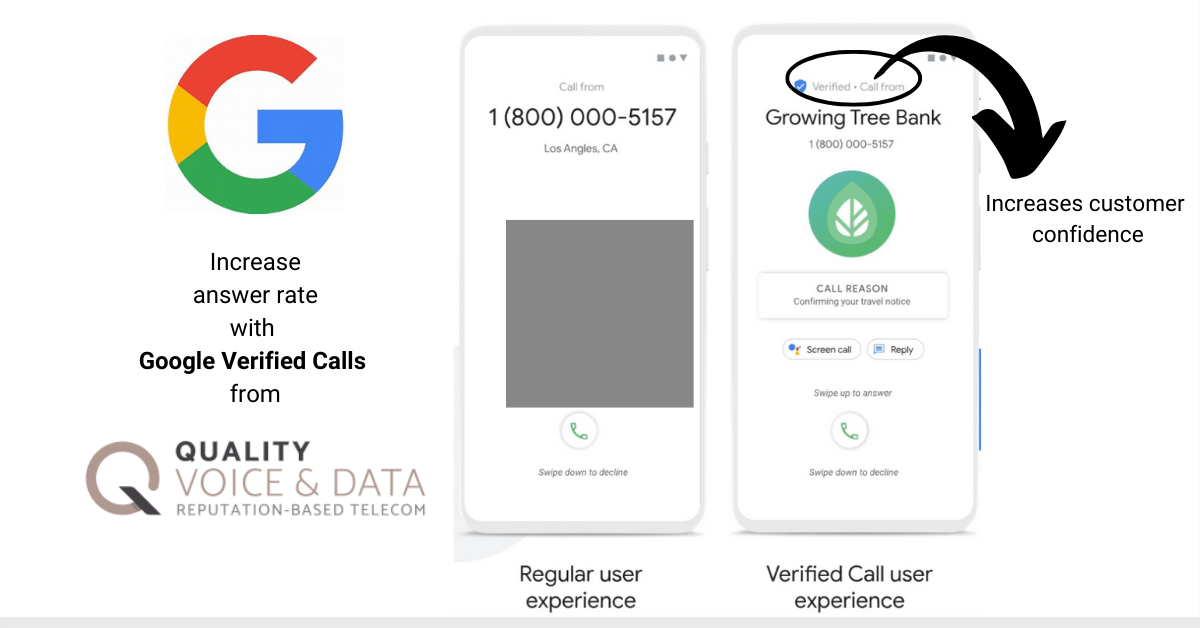Google Verified Calls delivers a verified business name, logo, and call reason
Google verified calls is the latest solution for giving customers more information about who is calling. Quality Voice & Data is delivering calls today with rich call data enabled, facilitating customers that use Google’s Phone app, including most Android phones, to see the business name, a logo, and the reason for the call. It’s called Google Verified Calls.
How Does Google Verified Calls Work?
It works like this: QVD first registers our customer’s Caller ID telephone numbers with Google. This includes providing basic verifiable information which includes our customer’s logo and a call description. Every time a QVD customer makes an outbound call, our switch makes an API call to Google Verify servers – informing Google we are calling one of its Google Verified Calls users. Google in turn sends a notification to the handset that includes our customer’s logo, the reason for the call and our customer’s telephone number.

Why is Google Verified Calls the future of getting calls answered?
Android phones make up 42% of the mobile phones in the U.S. market. That’s a much bigger number than I would have thought. The vast majority of the Android phones have the Google phone app preinstalled.
Google’s product guide notes that 87% of customers won’t answer if they don’t recognize the caller. In our experience, that is very accurate. The good news is that many QVD clients are already finding that Google Verified Calls are driving higher answer rates, improving efficiency, and increasing customer confidence.
Google Verified Calls gives legitimate callers a way to professionally present their information (like an e-business card). As end customers, we’ve all experienced the frustration of missing an important phone call because we didn’t answer the call based on what was displayed on the phone handset for Caller ID.
Real examples of the Google Verified Calls feature in use
Last week I was waiting for a callback from my health insurance provider. When they called me, the caller id display on my mobile phone displayed an 8xx number and no other data was presented to me. I assumed it was a robocaller and declined the call. They left a voicemail message, but by the time I listened to the message it was after hours. If the health insurance provider was using Quality Voice Data for their telecom, I would have seen the name of the company, their logo, and the reason for the call (customer service). I would have definitely taken the call.
Another example, each time I get a call from my dentist’s office, the call comes up as ‘spam likely’. I think it is because they are using an electronic health records system that includes an integrated telephony solution. In this instance, the EHR provider should partner with a company like Quality Voice & Data to pair each outbound Caller ID number with each dental office’s company name, logo and reason for calling (appointment confirmation, for example). In addition, the EHR provider will need to utilize QVD’s elastic SIP telecom service to ensure that the calls are delivered with the Google Verified Calls data.
What does the Google Verified Calls feature cost?
The end users don’t pay anything to see this rich call data displayed on their phone. Quality Voice & Data customers that purchase Caller ID Numbers and our elastic SIP trunking telecom services also do not pay extra for the service.
The future is Rich Call Data
The Google Verified Calls feature and others like it will soon become ubiquitous with all telecom services. It won’t be long until all major carriers offer Rich Call Data solutions that verify and identify who is calling. It’s been a long time coming and we’re ready!
Do you have questions? Schedule a no-obligation consultation today.
Angela Garfinkel, Director at Quality Voice and Data, brings over 30 years of experience in call center and business process outsourcing. Well known in the telemarketing and telecommunications industry, she co-authored a course for The Direct Marketing Association and actively participates in professional groups like PACE. Her educational background includes an MBA and an undergraduate degree in Telecommunications Management from the University of Nebraska.
